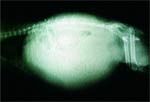Exploratory warranted with chyloabdomen
Signalment: Feline, Domestic Shorthair, 10 years old, female spayed, 12 lbs.
Signalment:
Feline, Domestic Shorthair, 10 years old, female spayed, 12 lbs.
Clinical history:
The owner presents the cat for ascites and hypoglycemia. The cat was diagnosed with diabetes mellitus several years ago and has been well-regulated until recently. Therapy has included Humulin L.

Image 1.
Physical examination:
The findings show rectal temperature 101.6°F, heart rate 195 beats/min, sinus rhythm, respiration 40 breaths/min, alertness, pink mucous membranes, mild dental disease and distended abdomen. Normal thoracic auscultation is noted.
Laboratory results:
The cat tested negative for FeLV and FIV infection. A complete blood count, serum chemistry profile, and urinalysis were performed and are outlined in Table 1.

Image 2.
Radiographic review:
Survey thoracic and abdominal radiographs are done. The thoracic radiographic views are unremarkable.
My comments:
The abdominal radiographs show evidence of severe ascites.
Ascitic fluid analysis:
Sample shows mildly increased cellularity and has a light purple background with abundant fine vacuolation. Cells are mostly small lymphocytes (62 percent) with lower numbers of polymorphs and macrophages with fine punctate cytoplasmic vacuoles. Sudan stain is positive. Interpretation: chylous effusion.

Table 1.
Ultrasound examination:
Thorough abdominal ultrasound is performed with the cat positioned in dorsal recumbency.
My comments:
There is a large amount of free fluid accumulated within the abdominal cavity. The liver shows a uniform echogenicity in its parenchyma. No masses noted within the liver parenchyma. The gall bladder is mildly distended, and its walls are not thickened or hyperechoic. The gall bladder does contain some sludge material. The spleen or a limb of the pancreas is enlarged, contains irregular margins, and is echobright in its parenchyma. The left and right kidneys are similar in size, shape and echotexture. No masses or calculi were noted in either kidney.
Case management:
The tentative diagnosis is chyloabdomen. At this point, an exploratory laparotomy would be warranted to confirm the presence of neoplasia and collect appropriate biopsies for histopathologic examination. Therapy thereafter would depend on the findings from the exploratory laparotomy and histopathologic examination.

Image 3 - 9.
Review of chyloabdomen
Various causes of chyloabdomen in adult cats are trauma, lymphoma, chronic pancreatitis, feline infectious peritonitis (FIP) and other cancers of the lymphatic system. Usually what happens in chyloabdomen is major lymphatic channel(s) break and allows the circulating lymph to leak into the abdominal cavity. The cause of the lymphatic channel breakage can be inflammation, neoplasia or idiopathic. Also, sometimes the chyloabdomen will leak into the thoracic cavity. I always try to radiograph the thorax before the chylous effusion occurs in the thorax so I can visualize the anterior mediastinum well for enlargement of lymph nodes and/or thymus. I also remember that chylous effusion of the thorax has been associated with feline heartworm disease. Management of the abdomen is to drain as much of the chylous fluid as possible through syringe aspirations, feed a low-fat diet and keep the cat as inactive as possible. Sometimes the lymphatic breaks will seal over after two to four weeks.
In the case presented above, exploratory laparotomy is needed to rule out lymphoma or another type of cancer. Therapy thereafter will depend on identifying the underlying cause of this intra-abdominal mass.
Dr. Hoskins is owner of DocuTech Services. He is a diplomate of the American College of Veterinary Internal Medicine with specialties in small animal pediatrics. Formerly a professor in the School of Veterinary Medicine at Louisiana State University, Dr. Hoskins is also the author of clinical textbooks on pediatrics and geriatrics. He founded an Internet service called "Vet-Web.com", where pet owners can e-mail animal health-related questions and he responds via e-mail. The Internet address is www.vet-web.com. He can be reached at (225) 751-9272.